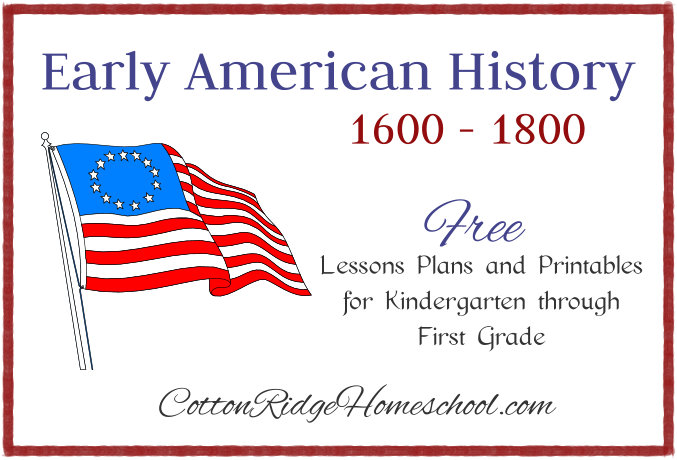Early American History: Colonial Life ~ Week 5 Lesson Plan For Kindergarten and First Grade
 This post is part of the Early American History series. For a suggested class schedule, an overview of the entire course, and links to more lesson plans, please see the introductory post.
This post is part of the Early American History series. For a suggested class schedule, an overview of the entire course, and links to more lesson plans, please see the introductory post.
In this lesson you will be teaching your students about life in the 13 colonies. Learn about daily life experienced by children in the 18th century.
Disclosure: I was not compensated for this post. I am an affiliate of Amazon, and will receive a small commission if a link on this page is used to make a purchase.
Suggested General Resources
- World Wall Map
- Map of U.S.A.
or 13 Colonies
- 13-Star U.S.A. Flag
for wall
- Posters of Early Americans
- Small Dot Stickers
- Washable Markers, Crayons, and/or Colored Pencils
- Glue Sticks
- Plates, Bowls, Napkins, Utensils, Small Cups
- Computer, Black and White Printer
(color printer optional), and Printer Paper
- Assembled Timeline File Folder for each child and Timeline Poster (click here for instructions and free printables)
- Assembled History Journal filled with Worksheets for each child (click here for instructions and free printables)
Additional Items Recommended For This Lesson
- If You Lived In Colonial Times
by Ann Mcgovern
- If You Lived At The Time Of The American Revolution
(optional)
- Great Colonial America Projects: You Can Build Yourself
- Heavy cream
- Glass jar with lid for each child
- Permanent marker
- Biscuits
- Apple cider
Week 5 Lesson Plan
For suggestions on how to conduct each activity below, please see the introductory post.
Year and Subject
1700 – 1775: Life in the 13 Colonies.
Map Activity
Name the 13 colonies as you point them out on a map (no dot stickers today).
Story
If You Lived In Colonial Times by Ann Mcgovern. I did not read this book straight through to my class – I picked out pictures and facts which I thought would interest them the most. I also displayed pictures from the book and asked them what they though, and we had a good discussion! You may also like to use If You Lived At The Time Of The American Revolution
as it contains a few illustrations that are not in the Colonial times book.
Timeline Figures
Please click here for Timeline instructions and free printables.
None
History Journal
Please click here for History Journal assembly instructions and free printables.
Page 9: Map of the 13 Colonies Coloring Page
Activity: Make Butter
Provide each child with a pint jelly jar with lid, half-filled with heavy cream. (Note: carton must be labeled “Heavy Cream.” You can find this in a grocery store near the milk.) To save time in class, write each child’s name on a lid with a permanent marker beforehand.
Tell the kids to shake their jar vigorously until lumps start to form in the jar. Depending on the temperature in your room, this could take from 5 to 15 minutes. The lumps are butter, and the remaining liquid is buttermilk.
There is an additional step of “cleaning” the butter that our class is not going to do. For a wonderful history of butter and detailed instructions on how to make and clean butter, please see this post from The Old Fashioned Way.
This activity can double as a snack: you can drink the buttermilk (or at least taste it), and the butter may be spread on crackers or biscuits right out of the jar. If you don’t want the kids to open their jars – to prevent a potential mess – make another jar of butter while the kids are making theirs. This way you only have to open one jar for the snack. Store the kids’ jars in a cooler until time to go home.
Food: Biscuits with Butter and Apple Cider
Apple cider and biscuits were common in Colonial times. The book Great Colonial America Projects: You Can Build Yourself has the list of supplies and the directions on how to make your own apple cider on page 65.
Make biscuits, allowing your children to help if possible, then bake and spread with the butter made in this lesson.
Timesaver snack idea: Purchase pre-made apple cider and frozen or refrigerated biscuits.
Craft Ideas
Please see my American History Pinterest Board for craft ideas! I’ll be adding images of the crafts we do in class on this post, also.
Additional Activity
Catch up on unfinished worksheets in the History Journals or make the mini-books from previous lessons.
Text Copyright 2015 Kathryn Depew
Colonial Williamsburg image from Flickr.com, used under the Creative Commons license. Credit: Sarah Stierch.



Leave a Reply